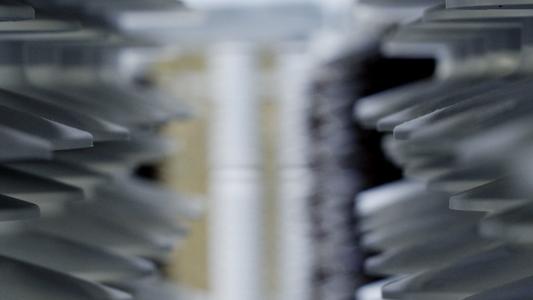In the first half of 2021, the wind energy transmitted from the German North Sea to shore by the transmission system operator TenneT amounted to 9.673 terawatt hours (TWh)*. Although this is around 16 percent less than in the first half of 2020 (11.51 TWh), the share of North Sea electricity in total wind power generation in Germany rose to 16.63 percent. This is 6.6 per cent more than in the first half of 2020, when the North Sea share was 15.6 per cent of total wind power generation.
In the Netherlands, the TenneT offshore grid connections transmitted 2.38 TWh in the first half of the year, which was a good 30 percent more than in the whole of 2020 (1.82 TWh). This is due to further expansion and the commissioning of the Borssele Beta offshore grid connection system in the second half of 2020. A further 1.5 TWh was fed directly into the Dutch TenneT grid onshore from Dutch offshore wind farms in the first half of 2021.
"The decline in offshore wind energy fed into the German grid is purely weather-related," said TenneT COO Tim Meyerjürgens, "there was simply less wind on the German North Sea in the first half of 2021 than in the first half of 2020," he said, adding that this was even more true for German onshore wind output, which fell by almost 22 per cent in the same comparison period - from around 60 TWh to around 47 TWh.
Tim Meyerjürgens continues: "Especially in years with less wind, the ratio of wind energy generated shifts towards offshore. There we generate on average about twice as many full-load hours as onshore and can thus partially compensate for lulls onshore. This shows the importance of the further expansion of offshore wind energy for security of supply and for a successful energy transition."
At the same time, politicians are increasing climate targets and electricity demand expectations, which is leading to ever greater technical challenges for TenneT as a transmission system operator. TenneT is facing up to this and is working successfully and at full speed on further grid expansion on land and at sea. TenneT already operates more than half of all offshore grid connections capacity in the EU. By 2030, TenneT will realise 16 more and then provide almost 29 gigawatts of wind power transmission capacity in the North Sea. In the same period, TenneT will invest around 20 billion euros in the Netherlands and Germany for this purpose.
An important focus at TenneT is on increasing the efficiency of the offshore connections and their future interconnection. To this end, solutions like the North Sea Wind Power hub programme with integrated interconnection solutions will be a major, important step forward. TenneT is part of a consortium working on this with the aim of having a first project ready for operation in the early 2030s.
Tim Meyerjürgens: "In order to achieve the increasingly ambitious climate and expansion targets in Europe, our constant technical innovations are leading the way. The expansion steps in the offshore grid from 700-megawatt AC and 900-megawatt DC connections to future DC connections with two gigawatt capacity give our projects the necessary thrust for a successful energy transition. And we need more bold ideas to consistently develop and improve the offshore grid."
At TenneT, this also includes measures that reduce CO2 emissions. For example, an LNG-powered laying vessel has now been used for the first time in the laying of offshore power cables during the construction of the DolWin6 grid connection project. The next deployment of this vessel is already in preparation at TenneT.
Further offshore balance data
In the German North Sea, the maximum value of the feed-in capacity of offshore wind farms in the first half of 2021 was measured on 29 January at 6,357 megawatts (MW). In the Netherlands, the maximum value was 2,252 MW on 19 January 2021. The capacity of Dutch offshore wind farms was 2,440 MW on the cut-off date of 30 June 2021.
In the German North Sea, the capacity expansion of offshore wind farms is stagnating. Capacity has remained unchanged at 6,679 MW since 2020.
Wind turbines in the Baltic Sea (50Hertz grid area) generated 1.819 TWh in the first half of 2021, 17.5 per cent less than in the first half of 2020 (2.205 TWh). Germany's total offshore wind output in the North Sea and Baltic Sea was therefore 11.492 TWh in the first half of 2021. Adding 46.657 TWh*) of onshore wind energy generated, the total wind yield in Germany comes to 58.15 TWh*).
*) Financially supported electricity quantities according to EEG, without other direct marketing and including 0.063 TWh unremunerated, due to negative prices; for 2021 as provisional actual value. Onshore electricity volumes are integrated as preliminary estimates for the months of May and June 2021.
TenneT
TenneT is a leading European grid operator. We are committed to providing a secure and reliable supply of electricity 24 hours a day, 365 days a year, while helping to drive the energy transition in our pursuit of a brighter energy future – more sustainable, reliable and affordable than ever before. In our role as the first cross-border Transmission System Operator (TSO) we design, build, maintain and operate 23,900 km of high-voltage electricity grid in the Netherlands and large parts of Germany, and facilitate the European energy market through our 16 interconnectors to neighbouring countries. We are one of the largest investors in national and international onshore and offshore electricity grids, with a turnover of EUR 4.5 billion and a total asset value of EUR 27 billion. Every day our 5,700 employees take ownership, show courage and make and maintain connections to ensure that the supply and demand of electricity is balanced for over 42 million people.
Lighting the way ahead together.




